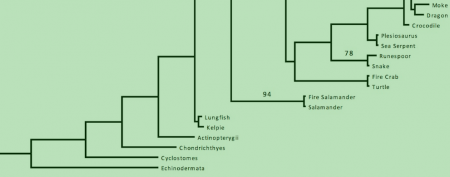(Click on the front page image to download the full article) Abstract: Metamorphmagi have the ability to change their physical characteristics at will, without requiring the use of potions or spells. As such, metamorphmagi skin contains morphologically and functionally distinct properties from non-metamorphmagi skin, providing metamorphagi with heightened skin flexibility and durability. However, previous studies that have examined metamorphmagi are largely qualitative or anecdotal. Thus, we aimed to quantitatively compare metamorphmagi skin to non-metamorphmagi skin and examine the genetic causes underlying metamorphmagi-specific skin characteristics.. We performed histology on cross-sections of skin and quantitatively demonstrated that the epidermis and dermis of…
The Science Creative Quarterly
Tagged Harry Potter
Genetic Association between WZRD-1 Variants and the Variation in Magical Abilities in Canadians
(Click on the front page image to download the full article) Abstract: Current literature lacks a consensus on the mechanism of biological inheritance of magical abilities. Past findings have suggested that the presence of restriction enzyme digestion sites in WZRD-1 are associated with variations in human magical abilities. In this study, Next Generation Sequencing (NGS) was performed to characterize the genetic sequence of WZRD-1 in 610 Canadian subjects. These individuals were divided into three cohorts as determined by their magical abilities and blood status. Four genetic variants within WZRD-1 were identified, and the genotypic and allelic frequencies were determined for…
MUTATIONS IN THE SEED REGION OF WIZARD mIR-96 ARE RESPONSIBLE FOR HEREDITARY PARSELTONGUE HYPERACUSIS
Annals of Praetachoral Mechanics (2016). Vol 2. Advanced online publication. download pdf ABSTRACT Parseltongue is a rare hereditary trait that allows wizards to communicate in the language of serpents. Wizards who are parseltongue not only have the ability to speak to serpents (parselmouth), but also possess the ability to hear ultrasonic frequencies produced by the snake (parseltongue hyperacusis). Genome wide association studies (GWAS) have identified scores of genetic variants that contribute to different wizarding phenomenon. MicroRNAs negatively regulate mRNA expression by binding complementary sites in target mRNAs, with the specificity of interaction being crucially dependent on the miRNA seed region.…
NucSh REGULATES NECESSARY NUCLEIC SHRINKAGE FOR GENOME SWAP IN POLYJUICE POTION
Annals of Praetachoral Mechanics (2016). Vol 2. Advanced online publication. download pdf ABSTRACT This study provides further investigations into the wizarding potion known commonly as the Polyjuice potion; and specifically to assess the contribution of the known fluxweed protein, NucSh. NucSh has been previously shown, via co-immunoprecipitation experiments, to be part of the PhageCrux Complex, which in turn appears to be key for many major transformative magic related properties. Other studies have also shown that the principle factor of this Auror favorite is possibly related to a symbiotically absorbed and retained bacteriophage present in Lacewing flies (Borage et al, 2009).…
IDENTIFICATION AND LOCALIZATION OF THE SANEW GENE IN MAGICAL WOLFSBANE (ACONITUM ALUPUS)
Annals of Praetachoral Mechanics (2016). Vol 2. Advanced online publication. download pdf ABSTRACT For more than 100 years, those suffering from werewolfism have relied on the Wolfsbane Potion to maintain cognitive abilities during transformation. Recent developments in biotechnology and biochemistry have allowed for in-depth study of the chemistry and genetics of magical plants such as Aconitum alupus, the most important herbal component of Wolfsbane Potion. A recent study identified mesaconitine as the potion-active metabolite of A. alupus, though the details of its biosynthesis have not yet been elucidated. In this paper we reported the discovery of the gene SANEW which…
EXPRESSION OF MaGc77 IS A SPECIFIC AND SENSITIVE MARKER FOR THE PATRONUS (Pt) CHROMOSOME (MGR-ABL1) TRANSLOCATION IN INHERITED MAGICAL ABILITIES
Annals of Praetachoral Mechanics (2016). Vol 2. Advanced online publication. download pdf ABSTRACT Magical abilities have been estimated to occur in about 17% of the human population. However, the cause of discrepancy between wizards/witches and muggles (non-magical humans) remains largely unknown. More surprisingly, the presence of squibs (individuals with no magical abilities despite a magical heritage) and muggle-born wizards and witches indicates a genetic component to magical abilities, which has yet to be understood. Recently, the MaGc77 protein was described as playing a potential role in the conference of magical abilities in individuals. Here we describe the underlying genetic event…
WZRD1 GENE, A POSSIBLE MARKER FOR SQUIBIDITY DISORDER IN HOMO SAPIENS
Annals of Praetachoral Mechanics (2016). Vol 2. Advanced online publication. download pdf ABSTRACT From the limited number of studies previously done on Squibidity, there is great potential for advancements that would further our understanding of this disorder, and which would benefit both magical and non-magical people. Squibidity, is one of the most mysterious conditions to affect the Wizarding world. It is estimated that approximately 1 out of every 1200 individuals, who are born into a Wizarding family, are affected. The severity of this condition varies, but most individuals with this phenotype lack the ability to perform magic of any kind,…
PRELIMINARY PHYLOGENY OF MAGICAL AND ORDINARY CREATURES: EVIDENCE OF A RECENT DIVERSIFICATION
Annals of Praetachoral Mechanics (2016). Vol 2. Advanced online publication. download pdf ABSTRACT We use phloygenetics to accurately describe the relationships between various taxa and elucidate patterns in evolution that leads to the great diversity of life we experience today. The events of “first contact” with the wizarding world has led to a stunning variety…
